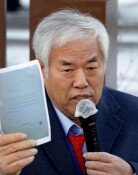Unresolved Doubts Over Blast in Yanggang
Unresolved Doubts Over Blast in Yanggang
Posted September. 13, 2004 22:03,
North Korean Foreign Minister Baek Nam-sun responded to a question by a British diplomat about the Yanggang explosion, saying, The explosion was part of the demolition of a mountain as a part of a hydroelectric project. In answer to the request to visit the explosion spot by Bill Rammell, U.K. Foreign Office minister who is visiting North Korea, he said, Well consider it. It appears the mystery over the explosion in Yanggang Province will be unveiled soon. However, Minister Baeks explanation left some unresolved doubts.
Deliberate Blast?-
Minister Baeks explanation was plausible on several points. First, North Korea created electric power by transferring waterpower resources from the Gaema Plateau to the Yalu River, where the waterfall creates strong power.
For instance, the Jangja River hydroelectric power plant, located in Wuiwon County, Jagang Province, creates 480,000 kw worth of electricity by opening a new waterway to the Yalu River and by stopping water from flowing to the Jangja River.
Kim Hyong-jik County in Yanggang Province, where the blast took place, is nicely situated for developing hydroelectric power. Neighboring Nangrim County has the Jangjin River, which has potential waterpower resources, and there is Nangrim Lake, about the size of Jangja Lake. In addition to that, there are several more rivers in Kim Hyong-jik County such as the Hoochang River in Walltan-ri, and the Hoidong River. So the area has a great potential for hydroelectric power projects.
North Korea has done commemoration blasting on major holidays in the past. The North also blasted during the Diamonds Mountain plant project and during highway construction from Pyongyang to the city of Nampo. They call this kind of blasting one million mountain blasting when the total amount of blasted dirt reaches one million tons.
In particular, the fact that North Korea has been gearing up its power plant projects due to its chronic electricity shortage, people are starting to believe that the explosion was a planned demolition of a mountain for a hydroelectric project.
Unsolved Doubts-
But it is hard to understand why the North didnt advertise their huge commemorative blasting on the 56th anniversary of North Koreas foundation on September 9. It has been traditionally a huge advertisement resource for them. When the size of the explosion enough to blow a mountain away, it must have taken several months of preparation. And the Pyongyang media should have been active in its advertisement by broadcasting congratulatory events with TV and newspaper coverage. However, the North Korean media has kept its silence over the explosion, and there were few news reports on the hydroelectric plant construction as an advance announcement. It is hard to be convinced of the absence of any media comments over such a big event in Kim Hyong-jik County, named for the grandfather of Kim Jong-il, the general secretary of the Labor Party of North Korea.
Another unsolved question lies in the fact that the explosion took place at night, when it is technologically very risky. Considering the safety of explosions, they conventionally happen during the day. Also, Pyongyang has made many of its explosions during the day, and in particular, they would direct an explosion event to occur during the daytime when it is important enough to be recorded.
zsh75@donga.com







